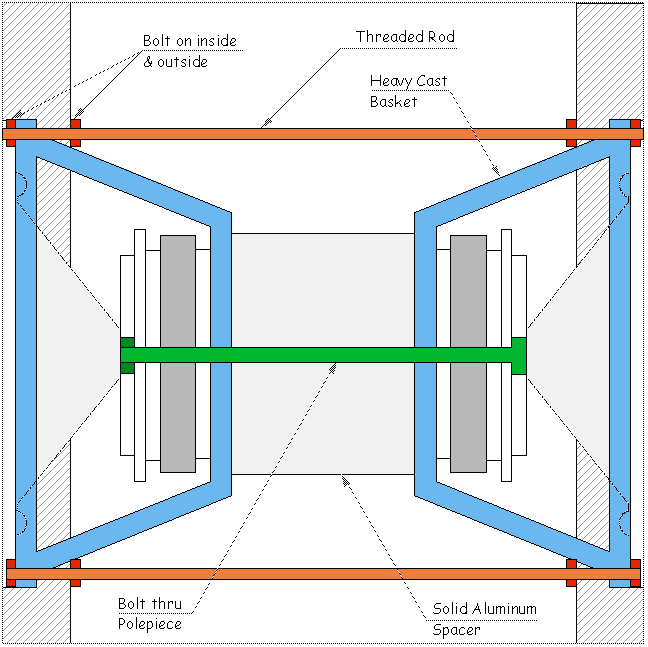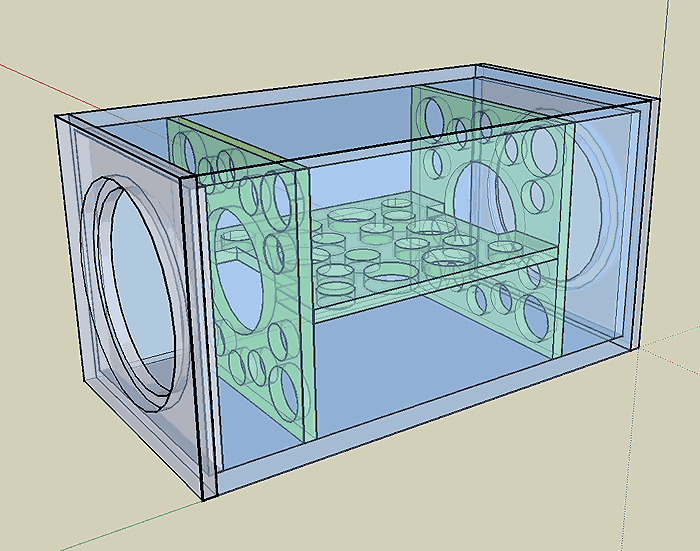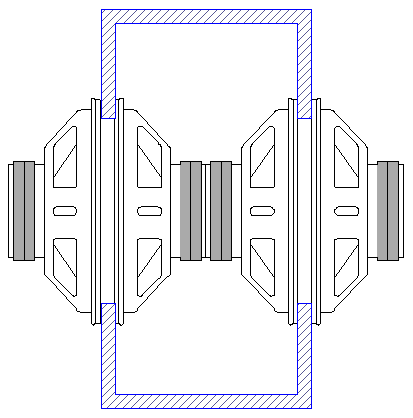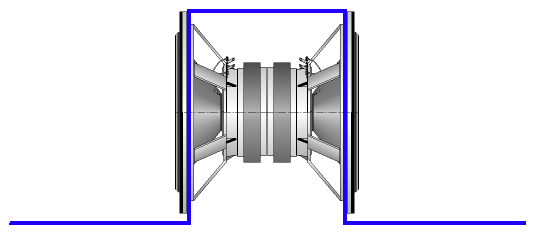Do drivers, esp. subs, shake their mounting boards? Why?
Cones react against the driver frame and, I guess, the mounting board or whole box is rigidly attached. But if the signal is close to symmetrical, why should there be shaking? An audio signal would feel like a buzz at audiio frequencies, not a shake (maybe 2 Hz?). Granted there is an initial pulse from, say, drums. But the DC (or 1 Hz) aspect of the drum output can't make it into (let alone right through) any audio-frequency system.
My OB giant sub shakes its mounting very profoundly when playing loud very low notes - and the wall to which the mounting board is attached. Just OBs?
Speakers don't shake except for panels that are containing pressure.
Cones react against the driver frame and, I guess, the mounting board or whole box is rigidly attached. But if the signal is close to symmetrical, why should there be shaking? An audio signal would feel like a buzz at audiio frequencies, not a shake (maybe 2 Hz?). Granted there is an initial pulse from, say, drums. But the DC (or 1 Hz) aspect of the drum output can't make it into (let alone right through) any audio-frequency system.
My OB giant sub shakes its mounting very profoundly when playing loud very low notes - and the wall to which the mounting board is attached. Just OBs?
Speakers don't shake except for panels that are containing pressure.
Last edited:
Hi bentoronto - well the short version is - yes, drivers shake their mounting boards. Here is a link to one thread on the subject: http://www.diyaudio.com/forums/multi-way/169521-open-baffle-vibrations.html
There is a lot of other stuff around including NOT using any baffle at all (Stig Erik) to using CLD (Constrained Layer Damping) stone, glass etc. http://www.perfect8.com/nav/pdf/EnclosureBaffleStudies.pdf
Good luck with your search about this problem - it has been, and still is, a work in progress by many others.
There is a lot of other stuff around including NOT using any baffle at all (Stig Erik) to using CLD (Constrained Layer Damping) stone, glass etc. http://www.perfect8.com/nav/pdf/EnclosureBaffleStudies.pdf
Good luck with your search about this problem - it has been, and still is, a work in progress by many others.
Hi,
Newtons third law "For every action, there is an equal and opposite reaction".
Your wrong about the frequencies, it must happen at all frequencies, and does.
After that it gets rather complicated when it comes to loudspeakers.
FWIW for OB's driver assymetry can cause DC forces related to the programs
level envelope that could cause rocking modes in large driver open baffles.
rgds, sreten.
Newtons third law "For every action, there is an equal and opposite reaction".
Your wrong about the frequencies, it must happen at all frequencies, and does.
After that it gets rather complicated when it comes to loudspeakers.
FWIW for OB's driver assymetry can cause DC forces related to the programs
level envelope that could cause rocking modes in large driver open baffles.
rgds, sreten.
Hi Dave,
I thought they did that to cancel out the non-linearity between the cone moving outwards and the cone moving inwards. Push-push tends to give you the same non-linearities in each direction.
As for the OB, it's still going to be excited by the drivers and tend to support vibration modes. At least they should now be equal in both directions. Sounds like fun, but what about the W.A.F. ?
-Chris
I thought they did that to cancel out the non-linearity between the cone moving outwards and the cone moving inwards. Push-push tends to give you the same non-linearities in each direction.
As for the OB, it's still going to be excited by the drivers and tend to support vibration modes. At least they should now be equal in both directions. Sounds like fun, but what about the W.A.F. ?
-Chris
Interesting reading c2cthomas's links to methods of addressing vibration. At different times, I've had bunches of concrete blocks or a wine rack sitting on top of my Klipschorn - which has a very convenient large top surface. If I were a golden-eared listener, I'd tell you how much my ears were opened by using one kind of concrete block versus another kind.
But no one in the first link addresses my question: why?
Comforting of sreten to document that Newton thought about these things. But more seriously, the issue of asymmetry of the driving signal has a few aspects. First, it relates to the ancient issue of absolute polarity in reproduction. Big can of worms. Second, wouldn't you find the cone on the other side of the room if there were a DC component somehow able to propagate itself through my AC-coupled amp?
Likewise push-pull mounting of a pair of drivers. Several benefits but again, if there were a polarity or DC aspect to the signal, it wouldn't reproduce the sound right. Finally, push-pull or single-driver, where are those shaking forces coming from?
I can't say if my bolted-to-the-drywall giant OB sub is shaking at its own personal resonance (incidentally stimulated by low notes) or is being driven more directly by the sub. And I guess it is important to understand which it is.
For sure, when driver energy is going into making stuff shake and when shaking stuff is making noise (not to mention the bunch of loose glass picture frames my wife has sitting on my giant OB sub), it has to be very harmful to sound quality.
But no one in the first link addresses my question: why?
Comforting of sreten to document that Newton thought about these things. But more seriously, the issue of asymmetry of the driving signal has a few aspects. First, it relates to the ancient issue of absolute polarity in reproduction. Big can of worms. Second, wouldn't you find the cone on the other side of the room if there were a DC component somehow able to propagate itself through my AC-coupled amp?
Likewise push-pull mounting of a pair of drivers. Several benefits but again, if there were a polarity or DC aspect to the signal, it wouldn't reproduce the sound right. Finally, push-pull or single-driver, where are those shaking forces coming from?
I can't say if my bolted-to-the-drywall giant OB sub is shaking at its own personal resonance (incidentally stimulated by low notes) or is being driven more directly by the sub. And I guess it is important to understand which it is.
For sure, when driver energy is going into making stuff shake and when shaking stuff is making noise (not to mention the bunch of loose glass picture frames my wife has sitting on my giant OB sub), it has to be very harmful to sound quality.
Last edited:
I thought they did that to cancel out the non-linearity between the cone moving outwards and the cone moving inwards. Push-push tends to give you the same non-linearities in each direction.
Push-pull id=s aimed at canceling some non-linearities. If you have good woofers not much benefit. Push-push on the other hand actively cancels most of the reactive forces, dramatically reducing energy machanically passed to the box.
dave
But no one in the first link addresses my question: why?
Comforting of sreten to document that Newton thought about these things. But more seriously, the issue of asymmetry of the driving signal has a few aspects. First, it relates to the ancient issue of absolute polarity in reproduction. Big can of worms. Second, wouldn't you find the cone on the other side of the room if there were a DC component somehow able to propagate itself through my AC-coupled amp?
Hi,
No. It has nothing to do with drive signal assymetry. The assymetry in the driver,
not the signal, can cause the "DC" position of the driver to vary with bass drive.
(Very generally, for cheap drivers, they tend to move backwards with drive.)
This means you will get a low frequency AC force (according to Newton) related
to the level of the bass envelope, this would cause the low frequency AC forces.
I think this does address the original question.
rgds, sreten.
Push - Push open baffle ? that is a new one on me ......
Last edited:
Yes, it's down to Newton's laws. But more subtly, one you have a driver (mass on a couple of different springs) mounted in a baffle (another mass, different stiffness) possibly all mounted in a subframe/wall (esp. drywall, which is hardly stiff) - you've got a nice system of coupled oscillators.
Then the maths gets hair-raising very quickly (think of a pendulum hanging from a pendulum...) and yes it's entirely possible to see large modes not apparently present in the driving function.
Then the maths gets hair-raising very quickly (think of a pendulum hanging from a pendulum...) and yes it's entirely possible to see large modes not apparently present in the driving function.
Push-Push Dipole Concept
An externally hosted image should be here but it was not working when we last tested it.
dave
Hi, I should of thought about it more, that is as described, rgds, sreten.
Reversing one driver and reversing its phase will still give force cancelling and 2nd
harmonic cancellation, but it wouldn't fix driver "DC" position issues, the above does.
Last edited:
Push-Push Dipole Concept
An externally hosted image should be here but it was not working when we last tested it.
dave
That concept looks verrrrrrrrry interesting Dave - me like it!!!

If I can ever put together a couple of $$$ I think I slap one of those together for a try. Of course I will need to work out a bit of the math (hmmmmmm - haven't done that stuff inawhile) about the size of the baffles etc. Ah heck - who needs that math stuff anyway - just go fer it and throw sum stuff together! (Just joking kids - I though I heard several folks grabbing their chest while they spit their beverage of choice out their nose).



Hi Dave,
It is a cool idea, and it does address the bass cancellation issues of open baffles. However, it does not qualify as an open baffle does it? It looks like a sealed or ported enclosure with drivers firing out each side.
Hi sreten, martin,
Yes, agree. A collection of moving masses coupled by compliances. Even a single box does not act as a solid block. Each panel will resonate at it's own resonance that may couple somewhere else in your system. I don't want to figure it all out.
If you place bright coloured adhesive dots in the middle of various panels and objects, then illuminate it all with fluorescent light (or similar), you'll be able get an idea of what is moving and by how much depending on signal levels. If you use an oscillator, you can identify each resonant frequency. Could be fun in fact.
-Chris
I'm sorry, but I can only see how this may affect the overall moment if you look at the box as a single solid mass. What is happening is that each wall experiences twice the force it would normally experience due to air pressure. If the drivers are not bonded together, then the moving mass of the driver system still affects each side independently until where each side is coupled where you can hope for some cancellation. It depends on how much energy was lost along the way.Push-push on the other hand actively cancels most of the reactive forces, dramatically reducing energy machanically passed to the box.
It is a cool idea, and it does address the bass cancellation issues of open baffles. However, it does not qualify as an open baffle does it? It looks like a sealed or ported enclosure with drivers firing out each side.
Hi sreten, martin,
Yes, agree. A collection of moving masses coupled by compliances. Even a single box does not act as a solid block. Each panel will resonate at it's own resonance that may couple somewhere else in your system. I don't want to figure it all out.
If you place bright coloured adhesive dots in the middle of various panels and objects, then illuminate it all with fluorescent light (or similar), you'll be able get an idea of what is moving and by how much depending on signal levels. If you use an oscillator, you can identify each resonant frequency. Could be fun in fact.
-Chris
I'm sorry, but I can only see how this may affect the overall moment if you look at the box as a single solid mass. What is happening is that each wall experiences twice the force it would normally experience due to air pressure. If the drivers are not bonded together, then the moving mass of the driver system still affects each side independently until where each side is coupled where you can hope for some cancellation.
The interior walls see no greater pressure than 2 drivers in the box (or even a single driver in an appropriatly smaller box -- force/unit area).
The more effectively the 2 drivers can be coupled the greater the force cancelation. Just usung the box walls is not all that effective.
Here is an illustration of an xtreme approach:

You get a significant portion of what is possible with just a good driver brace (avoid MDF).
An example (for a very specific woofer -- this would not be considered generic): woofer magnet plugs into, and is supported by, the vertical braces. Minimal baffle and tightly fitting horzontal brace provide good coupling.

dave
It is a cool idea, and it does address the bass cancellation issues of open baffles. However, it does not qualify as an open baffle does it?
Both examples before your post are OB. The 2nd image is a simplified view of the render on the webpage.
It does not address bass cancelation. You end up with a compound driver with all the same OB cancelation as a single driver.
dave
Reversing one driver and reversing its phase will still give force cancelling and 2nd harmonic cancellation, but it wouldn't fix driver "DC" position issues, the above does.
Take the concept a bit further. PushPush pair of PushPull drivers (not much use in an OB).

Something similar could be done on an OB, but wouldn't be as tightly coupled (and not isobarik).
dave
Hi,
I agree Isobaric stuff for open baffles means you don't understand Isobaric.
But to get back to the OP question, I think the cause is driver assymetry.
rgds, sreten.
The push-push arrangements would have some resonances higher up,
in fact you might as well fold back the side wings as far as I see it,
making it effectively a compound push-push folded W baffle.
I agree Isobaric stuff for open baffles means you don't understand Isobaric.
But to get back to the OP question, I think the cause is driver assymetry.
rgds, sreten.
The push-push arrangements would have some resonances higher up,
in fact you might as well fold back the side wings as far as I see it,
making it effectively a compound push-push folded W baffle.
Last edited:
Hi Dave,
I'm not criticizing the design at all. It looks interesting and shows the lengths it can take to avoid cabinet participation in the acoustic output (yuk, yuk, yuk). That goes to the original poster's concerns. I am curious as to how close you are getting to some type of enclosure in an acoustic sense. A simple OB it ain't.
-Chris
Yes,and the bracing is everything at those working pressures.The interior walls see no greater pressure than 2 drivers in the box
Yup. That's why I asked.The more effectively the 2 drivers can be coupled the greater the force cancelation. Just usung the box walls is not all that effective.
It's not that extreme. I've seen this in commercial production, same as the idea where you have internal bracing to hold / support the magnet structure.Here is an illustration of an xtreme approach:
Are they open to the sides Dave? Top and bottom also? Because you have a pair of baffles so close together, I'm not sure it acts the same way as the classic open baffle design. You have some acoustical passages there.Both examples before your post are OB
I'm not criticizing the design at all. It looks interesting and shows the lengths it can take to avoid cabinet participation in the acoustic output (yuk, yuk, yuk). That goes to the original poster's concerns. I am curious as to how close you are getting to some type of enclosure in an acoustic sense. A simple OB it ain't.
-Chris
- Status
- This old topic is closed. If you want to reopen this topic, contact a moderator using the "Report Post" button.
- Home
- Loudspeakers
- Subwoofers
- Do drivers shake their mounting boards?
